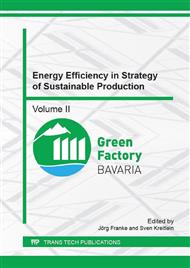[1]
International Energy Agency OECD/IEA, CO2 Emissions from fuel combustion – Highlights, 2015 Edition, Paris, (2015).
Google Scholar
[2]
A. Deckmann, S. Ferati, P. Karcher, S. Leu, R. Fourmont, Erfolgsfaktoren für die Einführung und den Betrieb eines Energiemanagementsystems nach DIN EN ISO 50001, R. Jochem (ed. ), first ed., Fraunhofer-Institut für Produktionsanagen und Konstruktionstechnik IPK, Berlin, (2014).
DOI: 10.30844/im_22-6_54-58
Google Scholar
[3]
V. Schmidt, M. Graßl, G. Reinhart, Contribution for the life cycle oriented evaluation of costs and resource efficiency of production machines in procurement, submitted to Applied Mechanics and Materials Vol. 655 (2014) pp.9-14.
DOI: 10.4028/www.scientific.net/amm.655.9
Google Scholar
[4]
Verband Deutscher Maschinen- und Anlagenbau VDMA, Prognosemodell für die Lebenszykluskosten von Maschinen und Anlagen (34160), (2006).
DOI: 10.1007/978-3-8349-9721-0_1
Google Scholar
[5]
M. Dervisopoulos, CO$TRA. Life Cycle Costs Transparent, Darmstadt, (2008).
Google Scholar
[6]
J. B. Dahmus, T. G. Gutowski, An Environmental Analysis of Machining, submitted to International Mechanical Engineering Congress and Exposition, (2004).
Google Scholar
[7]
F. Draganescu, M. Gheorghe, C. V. Doicin, Models of machine tool efficiency and specific consumed energy, submitted to Journal of Materials Processing Technology 141, 2003, p.9–15.
DOI: 10.1016/s0924-0136(02)00930-5
Google Scholar
[8]
A. R. Rodrigues, R. T. Coelho, Influence of the tool edge geometry on specific cutting energy at high-speed cutting, submitted to Journal of the Brazilian Society of Mechanical Sciences and Engineering 29, 2007, p.279–83.
DOI: 10.1590/s1678-58782007000300007
Google Scholar
[9]
M. U. Uluer, H. Ö. Ünver, K. Akkuş, S. E. Kılıç, A Model for Predicting Theoretical Process Energy Consumption of Rotational Parts Using STEP AP224 Features, submitted to Re-engineering Manufacturing for Sustainability, Singapore, (2013).
DOI: 10.1007/978-981-4451-48-2_23
Google Scholar
[10]
A. Pramanik, L. C. Zhang, J. A. Arsecularatne, Prediction of cutting forces in machining of metal matrix composites, submitted to International Journal of Machine Tools and Manufacture 46, 2006, p.1795–1803.
DOI: 10.1016/j.ijmachtools.2005.11.012
Google Scholar
[11]
H. -S. Yoon, J. -Y. Lee, M. -S. Kim, S. -H. Ahn, Empirical power-consumption model for material removal in three-axis milling, to Journal of Cleaner Production 78, 2014, p.54–62.
DOI: 10.1016/j.jclepro.2014.03.061
Google Scholar
[12]
H. Shao, H. L. Wang, X. M. Zhao, A cutting power model for tool wear monitoring in milling, submitted to International Journal of Machine Tools and Manufacture 44, 2004, p.1503–1509.
DOI: 10.1016/j.ijmachtools.2004.05.003
Google Scholar
[13]
M. Sarwar, M. Persson, H. Hellbergh, J. Haider, Measurement of specific cutting energy for evaluating the efficiency of bandsawing different workpiece materials, submitted to International Journal of Machine Tools and Manufacture 49, 2009, p.958.
DOI: 10.1016/j.ijmachtools.2009.06.008
Google Scholar
[14]
E. Abele, S. Braun, P. Schraml, Holistic Simulation Environment for Energy Consumption Prediction of Machine Tools, submitted to Procedia CIRP 29, 2015, p.251–256.
DOI: 10.1016/j.procir.2015.02.059
Google Scholar
[15]
J. Madan, M. Mani, J. H. Lee, K. W. Lyons, Energy performance evaluation and improvement of unit-manufacturing processes. Injection molding case study, submitted to Journal of Cleaner Production 105, 2015, p.157–70.
DOI: 10.1016/j.jclepro.2014.09.060
Google Scholar
[16]
T. G. Gutowski, M. S. Branham, J. B. Dahmus, A. J. Jones, A. Thiriez, D. P. Sekulic, Thermodynamic Analysis of Resources Used in Manufacturing Processes, submitted to Environmental Science & Technology 43, 2009 , p.1584–1590.
DOI: 10.1021/es8016655
Google Scholar
[17]
T. G. Gutowski, J. B. Dahmus, A. Thiriez, Electrical Energy Requirements for Manufacturing Processes, Cambridge, (2006).
Google Scholar
[18]
C. Eisele, Simulationsgestützte Optimierung des elektrischen Energiebedarfs spanender Werkzeugmaschinen, Aachen, (2014).
Google Scholar
[19]
W. Li, S. Kara, B. Kornfeld, Developing Unit Process Models for Predicting Energy Consumption in Industry: A Case of Extrusion Line, submitted to Re-engineering Manufacturing for Sustainability, Singapore, (2013).
DOI: 10.1007/978-981-4451-48-2_24
Google Scholar
[20]
S. Velchev, I. Kolev, K. Ivanov, S. Gechevski, Empirical models for specific energy consumption and optimization of cutting parameters for minimizing energy consumption during turning, submitted to Journal of Cleaner Production 80, 2014, p.139.
DOI: 10.1016/j.jclepro.2014.05.099
Google Scholar
[21]
G. Reich, M. Reppich, Regenerative Energietechnik. Überblick über ausgewählte Technologien zur nachhaltigen Energieversorgung, first ed., Wiesbaden, (2013).
DOI: 10.1007/978-3-8348-8614-9
Google Scholar
[22]
S. -J. Shin, J. Woo, S. Rachuri, Predictive Analytics Model for Power Consumption in Manufacturing, submitted to Procedia CIRP 15, 2014, p.153–158.
DOI: 10.1016/j.procir.2014.06.036
Google Scholar
[23]
J. M. Chien, D. Dornfeld, Semi-empirical Modeling of the Energy Consumed during the Injection Molding Process, Re-engineering Manufacturing for Sustainability, Singapore, (2013).
DOI: 10.1007/978-981-4451-48-2_49
Google Scholar
[24]
Y. Seow, S. Rahimifard, A framework for modelling energy consumption within manufacturing systems, submitted to CIRP Journal of Manufacturing Science and Technology 4, 2011, p.258–264.
DOI: 10.1016/j.cirpj.2011.03.007
Google Scholar
[25]
N. Weinert, Vorgehensweise für Planung und Betrieb energieeffizienter Produktionssysteme, Dissertation. Berlin, (2010).
Google Scholar


